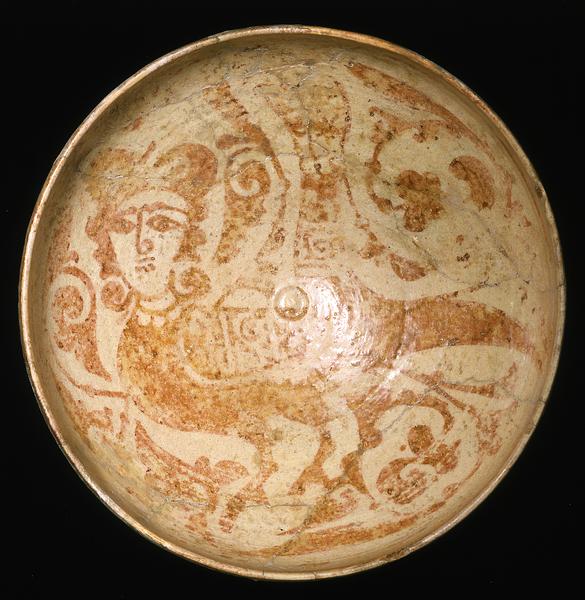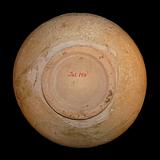Fritware bowl, painted with a lustre decoration over a transparent glaze. Tell Minis type
Syria; c. 1150
H: 11; Diam: 29 cm
Tell Minis ware marked an important stage in Syrian pottery production before Raqqa ceramics was made. The name Tell Minis comes from the hill between Hama and Aleppo where some 100 pieces of pottery were excavated in 1959. They were in fantastic condition and were technically distinctive in a number of ways. Most were fritware, in a few cases earthenware, but always with a fairly thin body. Most moreover had a ring foot that was cut inward diagonally so that the pieces only rested on a narrow edge. The fritware technique, the use of lustre, and the style of the decorations pointed to a close connection with Fatimid ceramics.
It has consequently been proposed that Tell Minis ware was made in Syria by Egyptian potters who had emigrated because of growing unrest in the Fatimid Empire. Other finds have shown that Tell Minis ware was produced in several places in Syria in the 12th century, including Raqqa. With its 14 pieces, the David Collection has one of the world’s largest holdings of Tell Minis ware
Inv. no. Isl 199
Published in:
C .L. Davids Samling. Fjerde Del : Jubilæumsskrift 1945-70, København 1970, cat.no. 9, p. 278;
Venetia Porter and Oliver Watson: "”Tell Minis" wares” in Oxford studies in Islamic art, 4, 1987, p. 207, cat.no. A8 and p. 222;
Kjeld von Folsach: Fabelvæsner fra Islams Verden, Davids Samling, København 1991, cat.no. 17;
Kjeld von Folsach: Art from the World of Islam in The David Collection, Copenhagen 2001, cat.no. 143;
Kjeld von Folsach: “A number of pigmented wooden objects from the Eastern Islamic worlds” in Journal of the David Collection, 1, 2003, p. 84, fig. 14;
Almut v. Gladiss (ed.): Die Dschazira: Kulturlandschaft zwischen Euphrat und Tigris, Museum für Islamische Kunst, Berlin 2006, cat.no. 10, p. 51 ;
Alexander Schubert (ed.): Richard Löwenherz: König - Ritter – Gefangener, Historisches Museum der Pfalz Speyer, Regensburg 2017, cat.no. 79;


